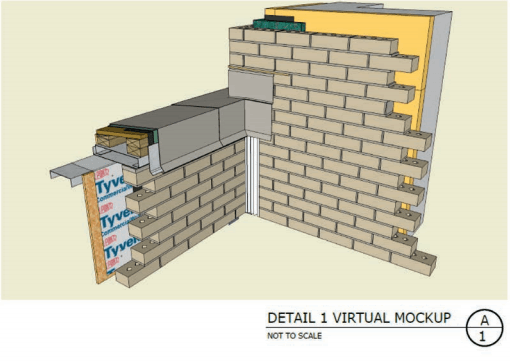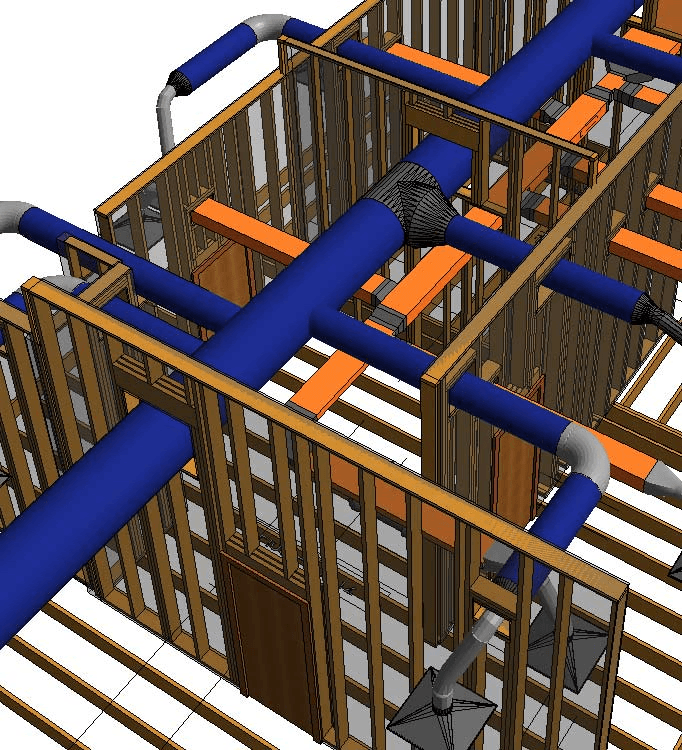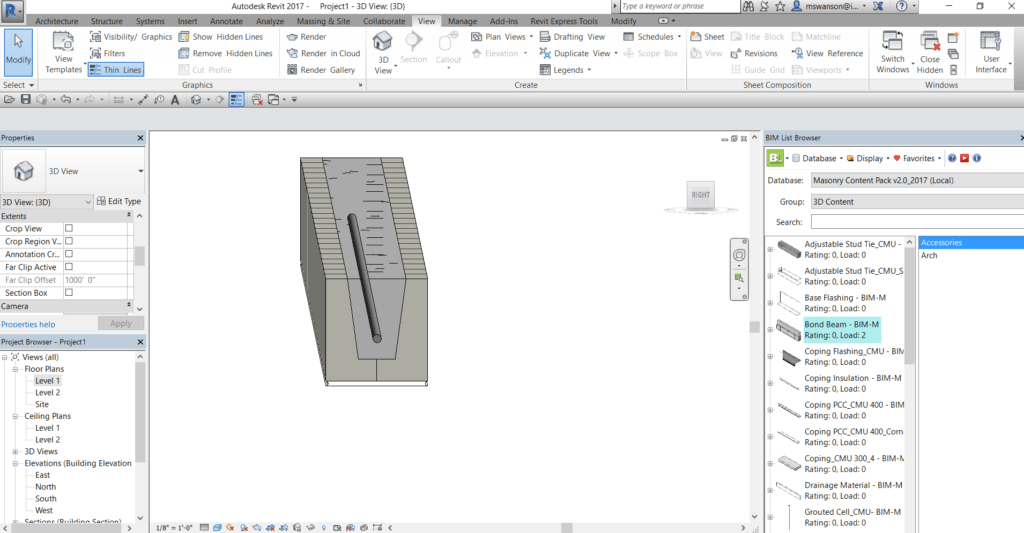
Words:Jamie L. Davis P.E., LEED AP, President, Ryan Biggs| Clark Davis Engineering & Surveying, D.P.C.
Chair, BIM-M TMS Committee
Photos: bimformasonry.org, RB/CD, strucsoftsolutions.com
As a structural engineer, I have seen firsthand the BIM revolution has greatly changed the way that we design and collaborate and create construction documents on a daily basis. Does BIM really affect a mason contractor? After all, no matter how a building is designed, in the end, the mason contractor is still using his or her skills to construct the building in the same fashion. So why should a mason contractor care about BIM?
To answer that question, let us step back. Way back. What is BIM? Really.
Obviously, the answer to that could take a novel, but let us hit the highlights. Above all else, BIM (Building Information Modeling) is a paradigm shift in how we work and collaborate. Think about how the design community approached design before BIM. Buildings are not flat, yet all of our design and coordination was done using 2D drawings to represent a 3D building. Hours spent pouring over 2D drawings to ensure that the architecture, structure, and mechanical systems would be coordinated when constructed in 3D. Then these 2D drawings are handed off to contractors in the hopes that they could recreate our 3D vision and intent.
BIM has changed this. Designers are now using 3D models for collaboration. Instead of comparing 2D drawings, we are now layering (federating) our 3D models together so we can instantly see whether we are coordinated in 3D. This in itself is a huge advancement for designers, but layer onto this, the 3D models are composed of elements, not linework, and these elements are data-rich. For instance, when modeling a steel structure, we are using 3D steel members, selected from a database, that are dimensionally accurate. You can imagine that this takes collaboration to a whole new level, allowing designers to coordinate structure, architecture, and mechanical systems with complete accuracy.
In addition, the models are intelligent and understand the connectivity of the elements within them. For example, if a column grid line is moved in a model, all of the columns on that grid line are instantly moved, the footings attached to those columns are moved, and all of the girders attached to the columns are moved on every level. A change that once took hours to make is now done instantaneously.
It is no wonder that the design community has embraced BIM! It has completely changed the way that we design and collaborate.
The changes do not stop there. BIM is transforming construction. Contractors are creating their own models, enhancing the design models to an even higher level of development, allowing them to ‘virtually’ construct a building before ever putting a shovel in the ground. These highly developed models are being prepared with the input of the subcontractors. So just as the architect, structural engineer, and mechanical engineers create and layer their models for coordination, so do the general contractors, steel fabricators, mechanical contractors create and layer their highly detailed models, enabling virtual clash detection to avoid real-life clashes in the field. Often, RFIs are generated from the models, pointing out discrepancies that can be resolved before issues arise in the field.

So back to the question at hand, why should a mason contractor care about BIM?
The answer is two-fold.
First, as the BIM revolution races forward, designers will lean towards using systems that have robust modeling tools. Second, Contractors will lean towards using subcontractors that are able to create and provide models to use for clash detection.
So the real question you should be asking is not why should a mason contractor care about BIM, but is the masonry industry keeping up with BIM so they don’t get left behind and become an archaic building system?
MASONRY AND BIM
Revitis a software program used to create models for BIM. There are many other programs (BIM Platforms) available, but Revit is the most widely used in the design community.
Unfortunately, the tools for designing masonry are not well developed in Revit. The Revit modeling tools available to date do not permit the type of functionality necessary for masonry coordination. From a designer’s perspective, we would like to have the masonry wall models include information that reflects accurate coursing and bonding so we can coordinate with other systems. Currently, Revit offers hatch patterns that can be placed on a wall, but the hatch patterns do not accurately represent the actual bonding or coursing of a wall system. They are in essence just an image of a bonding pattern, with no intelligent data. Creating custom patterns that would represent actual coursing and bonding is a timely effort within Revit.
Masonry Wall in Revit
Other wall construction materials like wood and light-gauge metal were faced with the same limitations within Revit, but those industries have developed software that can be used within Revit (plug-ins), that greatly enhance their modeling capabilities. These plug-ins allow designers to create highly detailed models that can be used to collaborate with other systems.
Light-gauge Model using StrucSoft Plug-In
Wood Model using StrucSoft Plug-In
For this same reason, mason contractors are not being ‘invited to the table’ with the other subcontractors that are providing construction-level models for coordination and clash detection. The tools simply did not exist to develop highly detailed masonry models.
This is why BIM-M, the Building Information Modeling for Masonry Initiative was started.The Initiative was started in 2013 tounifythe masonry industry and all supporting industries through the development and implementation of BIM tools for masonry.

Information can be found on the website:
BIM-M Initiatives
BIM-M has taken on the challenge of keeping masonry relevant in a BIM world in several ways. I will focus on three of our initiatives: education, the masonry unit database, and encouraging the development of masonry plug-ins.
Education:
Two publications, specifically for Masonry Contractors, are available for free on the BIM-M website:BIM Deliverables Guide for Masonry Contractors, Vol 1 and 2. These guides are written by mason contractors for mason contractors, and will help you negotiate the world of BIM. They provide examples of how Masonry Contractors across the country, large and small, are bringing BIM into their workplace and the savings they are seeing from doing so.
The key is to use the simplest tool that does the job. How will using BIM provide you a return on investment to help your business?
Fred Kinateder, a Masonry Contractor, gives seminars across the country to interested groups that want to learn more about how to leverage BIM.
Masonry Unit Database:
Probably the single largest stumbling block for masonry in a BIM world was the lack of an established database for masonry units. Unlike steel members that have a published AISC database of shapes, masonry shapes and naming conventions are not unified across the country and documented in a single source. Likewise, wood construction and light-gauge construction already had established naming conventions and standardized shapes that could easily be used in a database to create modeling tools. The first challenge of BIM-M was to create this database for masonry shapes. The database will be the backbone for the creation of masonry plug-in programs.
In Summer 2017, the first version of the Masonry Unit Database (MUD) was released.
Masonry Plug-Ins:
To keep pace with other materials that compete with masonry, it is crucial to have better modeling tools; tools that can easily provide accurate data within a model and assist designers and contractors in coordinating masonry with other trades.
Masonry Content Pack Plug-In:
BIM-M supported CTC Software in the development of a plug-in that provides accurate 3D and 2D representations of masonry units and wall systems. The plug-in is available as a free download from the BIM-M website.

Masonry IQ Plug-In:
3DIQ, by Tom Cuneio, has developed an advanced plug-in for masonry that this author feels is the most exciting advancement for modeling masonry.
The plug-in uses the dimensional information from the Masonry Unit Database, in conjunction with a selected bonding pattern and mortar joint width to create a ‘smart wallpaper’. The smart wallpaper accurately represents the bonding and coursing of all walls, even around corners. Openings can easily be located to align with mortar joints, framing can be coordinated with coursing, control joints can be located, and the location of field cuts of units identified. Designers are able to view accurate information in elevation, section, or plan views to inform their decisions and to coordinate the interface of structural, architectural, and mechanical systems. Whether designing with structural masonry, masonry veneer, or both, this plug-in will greatly assist the industry to design masonry buildings that are efficient for masons to construct and will eliminate costly field corrections.
Mason contractors are now using the 3DIQ developments to get ‘a seat at the table’ with other subcontractors. They are proving that masonry models can provide enormous value in the coordination process. Proving that masonry is not only a robust, efficient, timeless choice for designers, but it is also advancing to keep pace with modern technologies.
It’s time for Masonry Contractors to take a seat at the table or get left behind. For more information on how you can leverage masonry modeling, contact BIM-M.













